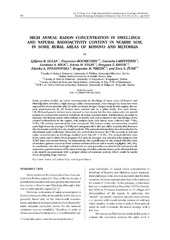Приказ основних података о документу
High Annual Radon Concentration in Dwellings and Natural Radioactivity Content in Nearby Soil in Some Rural Areas of Kosovo and Metohija
| dc.creator | Gulan, Ljiljana | |
| dc.creator | Bochicchio, Francesco | |
| dc.creator | Carpentieri, Carmela | |
| dc.creator | Milić, Gordana A. | |
| dc.creator | Stajić, Jelena M. | |
| dc.creator | Krstić, Dragana Ž. | |
| dc.creator | Stojanovska, Zdenka A. | |
| dc.creator | Nikezić, Dragoslav | |
| dc.creator | Žunić, Zora S. | |
| dc.date.accessioned | 2018-03-01T23:19:17Z | |
| dc.date.available | 2018-03-01T23:19:17Z | |
| dc.date.issued | 2013 | |
| dc.identifier.issn | 1451-3994 | |
| dc.identifier.uri | https://vinar.vin.bg.ac.rs/handle/123456789/5424 | |
| dc.description.abstract | Some previous studies on radon concentration in dwellings of some areas of Kosovo and Metohija have revealed a high average radon concentration, even though the detectors were exposed for three months only. In order to better design a larger study in this region, the annual measurements in 25 houses were carried out as a pilot study. For each house, CR-39-based passive devices were exposed in two rooms for the two consecutive six-month periods to account for seasonal variations of radon concentration. Furthermore, in order to correlate the indoor radon with radium in nearby soil and to improve the knowledge of the natural radioactivity in the region, soil samples near each house were collected and Ra-226, Th-232, K-40 activity concentration were measured. The indoor radon concentration resulted quite high from the average (163 Bq/m(3)) and generally it did not differ considerably between the two rooms and the two six-month periods. The natural radionuclides in soil resulted to be distributed quite uniformly. Moreover, the correlation between the(226)Ra content in soil and radon concentration in dwellings resulted to be low (R-2 = 0.26). The annual effective dose from radon and its short-lived progeny (5.5 mSv, in average) was calculated by using the last ICRP dose conversion factors. In comparison, the contribution to the annual effective dose of outdoor gamma exposure from natural radionuclides in soil is nearly negligible (66 mu Sv). In conclusion, the observed high radon levels are only partially correlated with radium in soil; moreover, a good estimate of the annual average of radon concentration can be obtained from a six-month measurement with a proper choice of exposure period, which could be useful when designing large surveys. | en |
| dc.relation | info:eu-repo/grantAgreement/MESTD/Integrated and Interdisciplinary Research (IIR or III)/41028/RS// | |
| dc.rights | openAccess | en |
| dc.source | Nuclear technology and radiation protection | en |
| dc.subject | radon | en |
| dc.subject | soil radioactivity | en |
| dc.subject | radiological impact | en |
| dc.title | High Annual Radon Concentration in Dwellings and Natural Radioactivity Content in Nearby Soil in Some Rural Areas of Kosovo and Metohija | en |
| dc.type | article | en |
| dcterms.abstract | Гулан, Љиљана Р.; Никезиц, Драгослав Р.; Стојановска, Зденка A.; Зуниц, Зора С.; Боцхиццхио, Францесцо; Царпентиери, Цармела; Милиц, Гордана A.; Стајиц, Јелена М.; Крстиц, Драгана З.; | |
| dc.citation.volume | 28 | |
| dc.citation.issue | 1 | |
| dc.citation.spage | 60 | |
| dc.citation.epage | 67 | |
| dc.identifier.wos | 000317709800008 | |
| dc.identifier.doi | 10.2298/NTRP1301060G | |
| dc.citation.rank | M23 | |
| dc.identifier.scopus | 2-s2.0-84877886404 | |
| dc.identifier.fulltext | https://vinar.vin.bg.ac.rs//bitstream/id/13374/5420.pdf |

